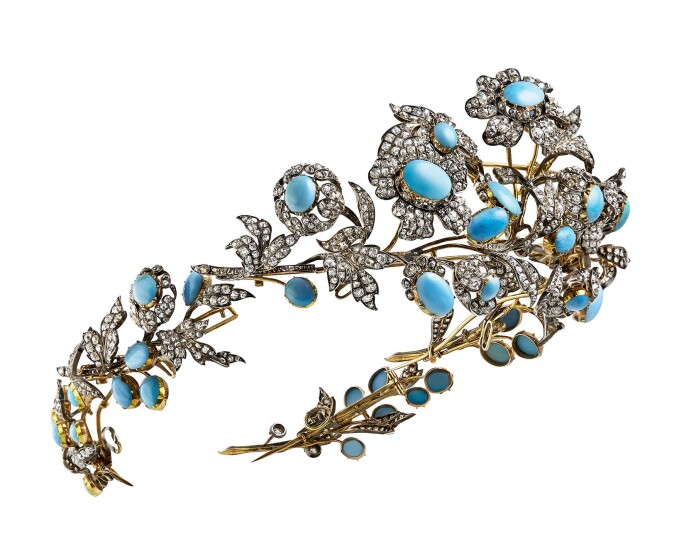P arisian master jeweler, Mellerio, lays claim to being the oldest jeweler in the world, tracing its family lineage to 1613, to goldsmiths and jewelers who, a century earlier, in 1515, moved from Lombardy in Northern Italy, to France, to ply their trade, peddling precious objects. It was in 1613 that Marie de Medici, then Regent of France, granted the Italian family royal protection, allowing them to trade in their adopted country, “to carry cut crystal, trinkets and other small goods” from Paris and throughout the kingdom, without administrative restrictions; a privilege that was renewed by subsequent French kings.

The connection to Marie de Medici was to pave the way for Mellerio’s long history of royal clients: it is reported that in 1780, Jean-Baptiste Mellerio sold a bracelet, set with cameos, framed in rubies, in the prevailing neo-classical taste, to Marie Antoinette.
In 1815, his cousin, Jean-François Mellerio opened a boutique on the rue de la Paix, the first jeweler to be installed on the fashionable street, and from this time, throughout the century, the company created exceptional jewels, always set with the finest gem-stones, diamonds, coloured gems and pearls, and in the very latest style. Dating from 1825, for example, is a parure set with amethysts in gold cannetille, the filigree work that is so typical of this period. It was a style favoured by Empress Josephine, to whom Mellerio became an appointed jeweler. Later, towards the mid-century Mellerio specialised in the naturalistic floral jewels that were all the rage, depicting roses, ivy, fuchsia or snowdrops, and famously, a magnificent diamond rose corsage ornament commissioned by Princess Mathilde. Many featured the technique known as ‘en pampilles’, with articulated, graduated streams of diamonds trickling from luscious diamond blossoms or green enamelled ivy leaves. In 1854, Mellerio applied for a patent for a flexible stem that would add yet more suppleness, refinement and extra realism to these distinctive naturalistic jewels.

The beauty of the jewels, along with the company’s particular pride in forging close relationships with its clients, brought a flurry of royal appointments, starting in 1830, when Mellerio officially became jeweler to the court of King Louis-Philippe. This was followed by appointments to the King of Italy, who bought a wild rose tiara for his future daughter-in-law, in 1868, and the Royal Court of the Netherlands, which ordered a sumptuous ruby suite in 1888, while Queen Isabella of Spain became a loyal client after Mellerio opened a branch in Madrid in 1848. In 1867, she purchased a ‘rocaille’ tiara, designed as a frieze of diamond shells, each set with a pearl, which is still worn today by Queen Letizia of Spain. And despite the company’s links to the ancien regime, Mellerio flourished during the Second Empire, enjoying the patronage of Napoleon III and Empress Eugénie.

Mellerio received huge critical acclaim for the jewels exhibited at the various International Exhibitions in London and Paris through the second half of the 19th century and into the 20th, starting with naturalistic jewels exhibited in Paris in 1855. A highlight amongst the jewels on display at the 1862 Exhibition in London was Mellerio’s life-like lilac spray corsage ornament, each of its clustered enamelled florets centred on a tiny diamond. It has become a seminal 19th century jewel. Then in 1867, in Paris, Mellerio presented a stunning peacock feather brooch, with a flexible stem and floating strands of diamond fronds around an ‘eye’ centred on a sapphire, rimmed in emeralds and rubies. It was bought by the Duchess of Medina Coeli, and Empress Eugénie ordered a second version, with an emerald centre. The peacock feather became a Mellerio signature, the theme re-imagined in 1905 as a dramatic Art Nouveau jewel, the enamelled bird with spreading gem-set tail feathers, a symbol of the pride and magnificence of nature and the poetry of Art Nouveau.
Mellerio specialised in combining the latest styles with superb gems and craftsmanship, capturing, for example, the historical revivals of the late 19th century, including Egyptian-revival jewels, created in 1869 to celebrate archaeological finds and the opening of the Suez Canal in 1869. Generations of the Mellerio family perpetuated this legacy, leading the company through the Louis XVI revival of the Belle Epoque, the modernism of Art Deco and the cocktail-style exuberance of the 1940s. In the 1950s, the Golden Age of couture, Mellerio collaborated with the great Paris fashion houses, Dior, Balenciaga, Jean Patou, accessorizing shows with their precious jewels.
More recently, Mellerio had paid homage to their long and rich heritage in contemporary designs. In 2005, they launched their own Mellerio diamond cut, an elegant cross between a pear and an oval, with extraordinary radiance and a nobility that recalls their royal and aristocratic clientele. In 2013, to celebrate their 400th anniversary, the company turned to Paris-based French-Canadian designer-jeweler, Edéenne, to create a special High Jewelry series, the Medici collection, which included a spectacular openwork neck-ornament inspired by Marie de Medici’s famous lace collars, and a bodice ornament, designed as a diamond lily, trailing a long pearl tassel. Today, Mellerio remains the only independent, family-owned and run luxury French jewelry Maison, with Laure-Isabelle Mellerio at the helm, as president and creative director.

